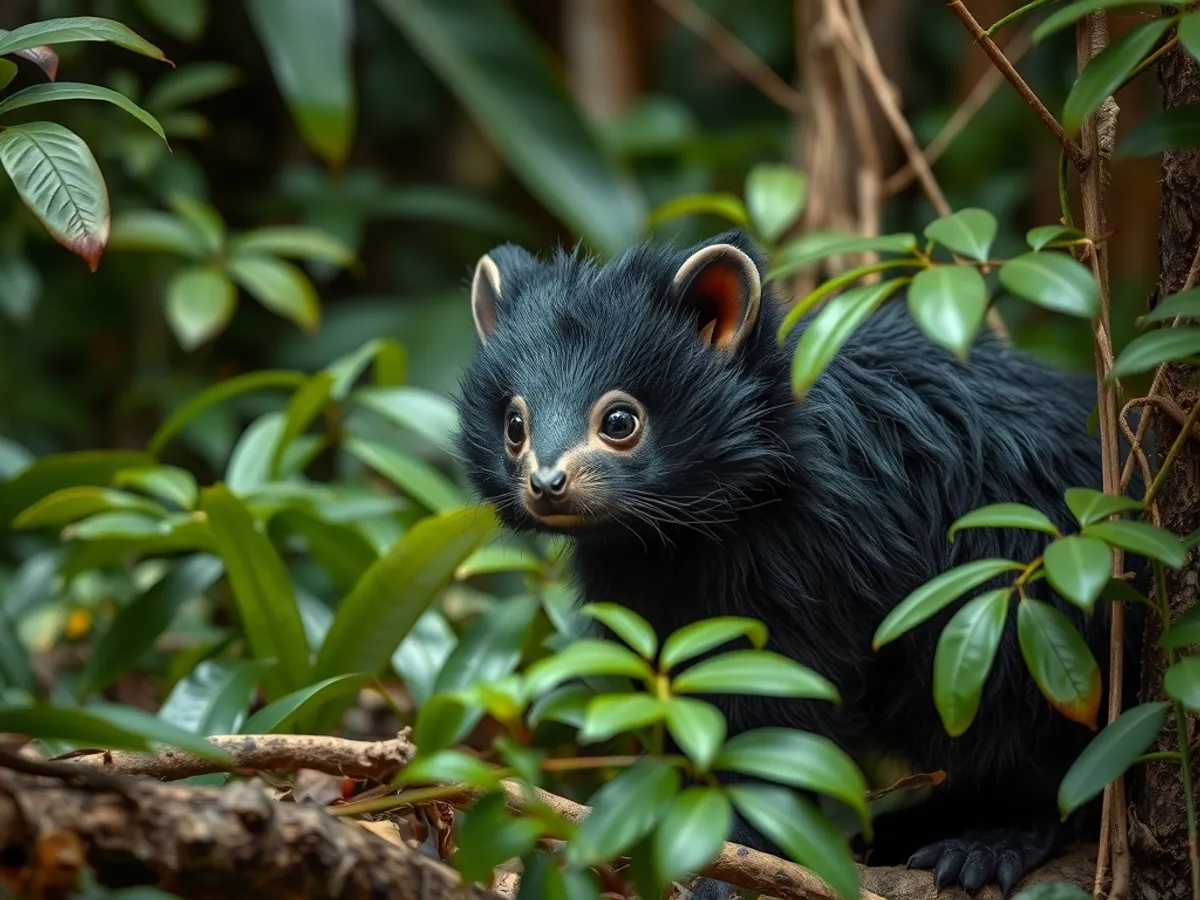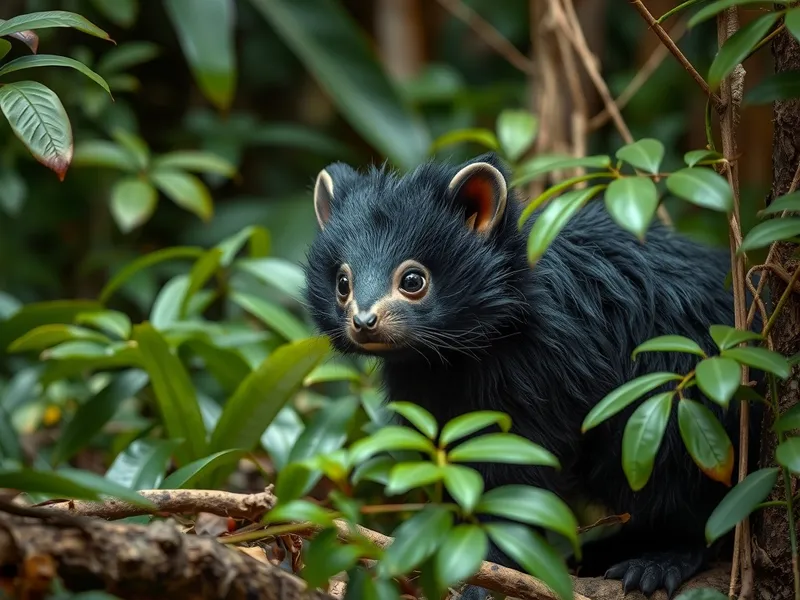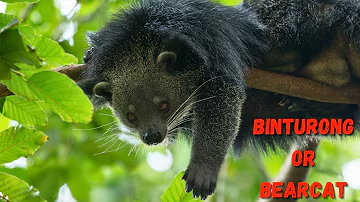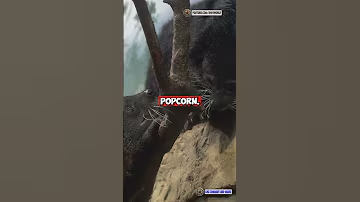
Binturong
Arctictis binturong

Meet the Binturong
The Binturong, also known as the bearcat, is a large, arboreal mammal native to the dense forests of Southeast Asia. Despite its nickname, it is neither a bear nor a cat, but a member of the Viverridae family, related to civets and genets. Binturongs have thick, coarse black fur, a prehensile tail, and a distinctively musky scent reminiscent of buttered popcorn. These nocturnal omnivores spend much of their time in the treetops, using their tails for balance and grasping branches. Due to habitat loss and hunting, Binturongs are classified as Vulnerable in the wild.
Classification
Mammal
Habitat
Tropical rainforest
Diet
Omnivore
Lifespan
15-25 years
Conservation
Vulnerable
Weight
9-20 kg
📖Fascinating Facts
Arboreal Lifestyle
Binturongs spend most of their lives in the forest canopy, using their prehensile tails to grip branches and move with agility high above the ground.
Popcorn Scent
Their scent glands emit an odor strikingly similar to buttered popcorn, which helps them mark their territory and communicate with other binturongs.
Seed Disperser
Binturongs are critical seed dispersers for fig trees, as the seeds pass through their digestive systems and germinate more easily after being excreted.
📋Detailed Description
The binturong (Arctictis binturong) is a robust, arboreal mammal distinguished by its shaggy, coarse black fur, bushy tail, and prominent white facial whiskers. Adults typically measure 61–97 cm (24–38 in) in body length, with a prehensile tail nearly as long as the body (56–89 cm/22–35 in), and weigh between 9–20 kg (20–44 lb), with females generally larger than males—a rare example of sexual dimorphism among carnivores. Its head is broad with small, rounded ears edged in white, and its eyes are large and forward-facing, aiding nocturnal vision. The binturong's most unique feature is its prehensile tail, which acts as a fifth limb for climbing and grasping branches, a trait unique among Old World carnivores. Its feet are plantigrade, with semi-retractable claws and specialized scent glands under the tail that produce a musky odor reminiscent of buttered popcorn. Binturongs are primarily nocturnal and crepuscular, spending most of their time in the forest canopy, where their slow, deliberate movements and cryptic coloration provide camouflage. They are omnivorous, feeding on fruits (notably figs), small vertebrates, eggs, and invertebrates. Binturongs are generally solitary or found in small family groups, and are known for their vocalizations, including chuckles, grunts, and high-pitched wails. Their lifespan in the wild is estimated at 10–15 years, but they can live over 20 years in captivity.
💡 Did you know?
Binturongs play an important ecological role by dispersing the seeds of strangler fig trees, which depend almost entirely on them for propagation.
🔬Research & Sources
Wikipedia Summary
The binturong, also known as the bearcat, is a viverrid native to South and Southeast Asia. It is uncommon in much of its range, and has been assessed as Vulnerable on the IUCN Red List because of a declining population. It is estimated to have declined at least 30% since the mid-1980s. The binturong is the only species in the genus Arctictis.
Last Modified: 5/26/2025
🎭Behavior & Social Structure
Binturongs are predominantly solitary, though mothers may be accompanied by dependent offspring. They are highly arboreal, rarely descending to the ground except to move between trees or access water sources. Their daily activity peaks at dusk and dawn (crepuscular), but they may also be active at night. Binturongs use their prehensile tails for balance and to anchor themselves while foraging or resting in trees. They are slow and deliberate climbers, using all four limbs and their tail to navigate branches. Their omnivorous diet is heavily fruit-based, with figs (Ficus spp.) forming a significant portion, but they also consume leaves, shoots, bird eggs, small mammals, insects, and carrion. Binturongs are known to play a vital ecological role as seed dispersers, especially for fig trees, due to their ability to pass viable seeds through their digestive tract. They communicate through a range of vocalizations and scent-marking, using their anal glands to delineate territory or attract mates. While generally non-aggressive, they may exhibit defensive behaviors such as hissing or growling when threatened.
👶Reproduction & Life Cycle
Binturongs are polyestrous and capable of breeding year-round, though some populations show peaks in births during the dry season. Females exhibit induced ovulation and can experience delayed implantation, allowing flexibility in timing births to favorable conditions. After a gestation period of approximately 91–99 days, females give birth to litters of 1–6 young (commonly 2–3). Neonates are born blind and helpless, weighing about 283–340 grams (10–12 oz), and are cared for exclusively by the mother. Eyes open after about 10 days, and young begin to eat solid food at 6–8 weeks, but may nurse for up to 3 months. Juveniles remain with the mother for several months, learning climbing and foraging skills. Sexual maturity is reached at 2.5–3 years. In captivity, binturongs have been observed to live up to 25 years, though wild lifespans are likely shorter due to predation and environmental hazards.
🛡️Adaptations & Survival
The binturong's prehensile tail is a rare adaptation among Old World carnivores, allowing it to securely grip branches and hang while foraging, freeing its forelimbs for manipulation. Its plantigrade feet and semi-retractable claws provide enhanced grip and maneuverability in the canopy. The dense, coarse fur protects against rain and insect bites, while the musky scent produced by its anal glands serves both as a territorial marker and a deterrent to predators. Its omnivorous dentition, with robust molars and sharp canines, allows efficient processing of both animal and plant matter. The binturong's digestive system is adapted to process fibrous fruits, and its role as a seed disperser is crucial for forest regeneration. Its nocturnal and crepuscular habits reduce competition and predation risk, while its cryptic coloration aids in camouflage.
🎨Cultural Significance
The binturong holds varying significance across its range. In some Southeast Asian cultures, it is associated with folklore and is believed to possess mystical powers or medicinal properties. Its musk is sometimes used in traditional medicine or as a base for perfumes. In parts of the Philippines, binturongs have been kept as pets or used to control rodent populations. However, these practices have contributed to population declines. The animal's unique appearance and behavior have made it a subject of curiosity and symbolic representation in local art and storytelling.
🔬Recent Research & Discoveries
Recent research has focused on the binturong's ecological role as a key seed disperser, especially for strangler figs, which are keystone species in Asian rainforests. Studies using radio telemetry have revealed large home ranges and strong site fidelity, emphasizing the need for extensive, connected habitats. Genetic studies are underway to clarify subspecies boundaries and population structure, with up to nine subspecies currently recognized, though taxonomic revisions are ongoing. Captive breeding programs in zoos aim to bolster genetic diversity and provide insights into reproductive biology. Ongoing research also investigates the chemical composition of binturong scent glands and its potential functions in communication. Conservationists are advocating for landscape-level habitat protection and community-based conservation initiatives to mitigate human impact.
🎥Wildlife Videos

Binturong: The Bearcat that is Neither Bear nor Cat
Special Thanks to the Cincinnati Zoo. Support Animalogic on Patreon: https://www.patreon.com/animalogic Subscribe for new ...
Animalogic

What Makes the Binturong Unique Among Southeast Asian Wildlife? #animals #wildlife #documentary
The binturong, often called the "bearcat," is a nocturnal mammal native to Southeast Asia. With its intriguing mix of bear-like and ...
Hidden Creatures

Binturong Popcorn Smelling Bearcat
Binturong - Popcorn Smelling Bearcat The binturong, or bearcat, a whiskery, bear-faced oddball from Southeast Asia, waddles ...
Odes For the Lost Soul

Dr. Evan Antin Bonds with an Incredibly Friendly Palawan Bearcat | Evan Goes Wild
In the Philippines, Evan visits a Butterfly Eco Garden where he gets a once in a life time opportunity to play with a palawan bearcat ...
Animal Planet

Binturong The Mysterious 'Bearcat' Unveiled! | Popcorn Smelling Binturongs
The binturong, also known as the bearcat, has a surprising secret—it smells just like buttery popcorn! But why? In this video, we ...
Wildlife Pedia English

🐾 The Binturong – The “Bearcat” with a Secret Smell! 🌿🔥
The Binturong – The “Bearcat” with a Secret Smell! Meet the Binturong, also known as the "bearcat," a mysterious mammal ...
Ases World
🌍Habitat Information
The Binturong typically inhabits Tropical rainforest environments. Binturongs have adapted to their environments with specialized features and behaviors.
Primary Habitat:
Tropical rainforest
More detailed habitat information will be available soon.
🛡️Conservation Status
The Binturong is currently classified as Vulnerable. Conservation efforts are crucial for preserving this species for future generations.
Common Threats:
- 🏠Habitat loss and fragmentation
- 🌡️Climate change impacts
- 🎯Hunting and poaching
- 🏭Human-wildlife conflict
⚠️Threats & Conservation Challenges
The binturong faces significant threats from habitat loss due to deforestation, agricultural expansion (notably oil palm plantations), and logging throughout its range in South and Southeast Asia. It is also targeted by hunting for meat, traditional medicine, and the pet trade. Fragmentation of forest habitats isolates populations, reducing genetic diversity and increasing vulnerability to local extinction. Road mortality and human-wildlife conflict are additional concerns in some areas. The IUCN Red List classifies the binturong as Vulnerable, with an estimated population decline of at least 30% over the past three decades. Conservation challenges include limited ecological data, low reproductive rates, and difficulties in enforcing wildlife protection laws.
🔬Scientific Classification
Scientific Name
Arctictis binturong
Classification Hierarchy
🔍 About Taxonomic Classification
Taxonomic classification is a hierarchical system used by scientists to classify and organize living organisms based on shared characteristics and evolutionary relationships.
The system moves from broad categories (Kingdom) to increasingly specific ones, with each animal's scientific name typically consisting of its Genus and species.
📝Community Notes
Share your observations and insights about the Binturong with our community of wildlife enthusiasts.
Join Our Community
Sign in to share your observations and connect with fellow wildlife enthusiasts.
Sign In to ContributeNo community notes yet
Be the first to share your observations about the Binturong!
Explore Binturong
Select a tab above to learn more about this amazing animal.
📸Photo Gallery
No photos available for this animal yet.
🌟Discover More Wildlife
Continue your journey of discovery with more fascinating animals from our database
